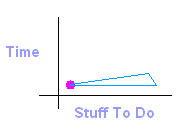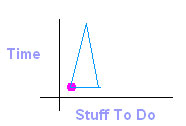One of the ways to get things done faster is to set a tight deadline…and then pare down the task at hand to the bare essentials.
The setting of tight deadlines is known as time compression, and it can spur creativity. But if you set a close deadline, it is essential that you also get rid of the non-essential parts to the task. Here’s why:
There are three basic elements in any item that needs to be done:
- how many people are doing it
- the time allotted
- the amount of stuff to do
Think of it this way: you have a piece of string. You make a knot in the string to form a loop, then pin the knot to your desk. This represents the people; in this case, you. Now put take two fingers and put them on the inside of the loop so that they pull the string into a triangle.
Visualize this on a graph. The y-axis is (negative) time, or the time closest to the pinned point is the furthest away in true time; and x-axis is the amount that can be done. If time is very far away from today (low on the y-axis), the amount that can be accomplished is greater (Fig. 1). If you move time far up the y-axis, or require something to be done sooner, the amount that can be done must be reduced. (Fig. 2)
Figure 1 
Figure 2 
So it follows that if you need to get something done quicker, you need to eliminate things from what needs to be done.
Fixing the second point of amount to be done does not allow you to move the time frame. Conversely, if you don’t eliminate things from the task at hand, part of you will be resisting the task from the belief that there is too much to do in the short time span.






